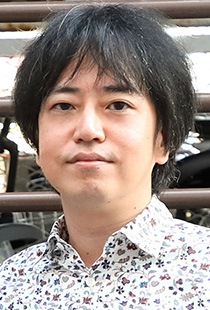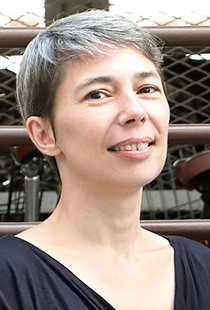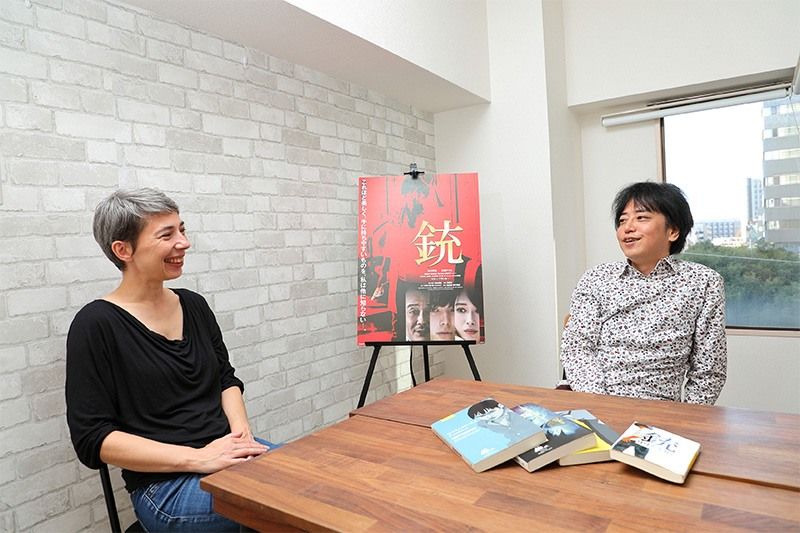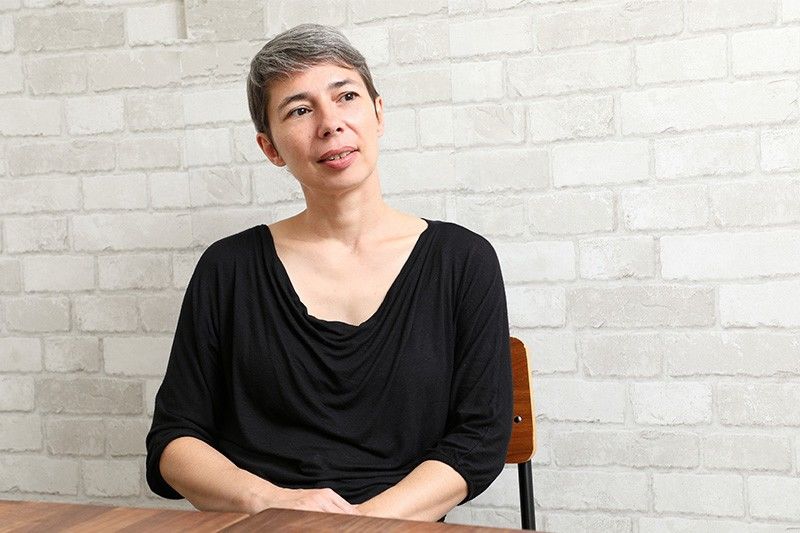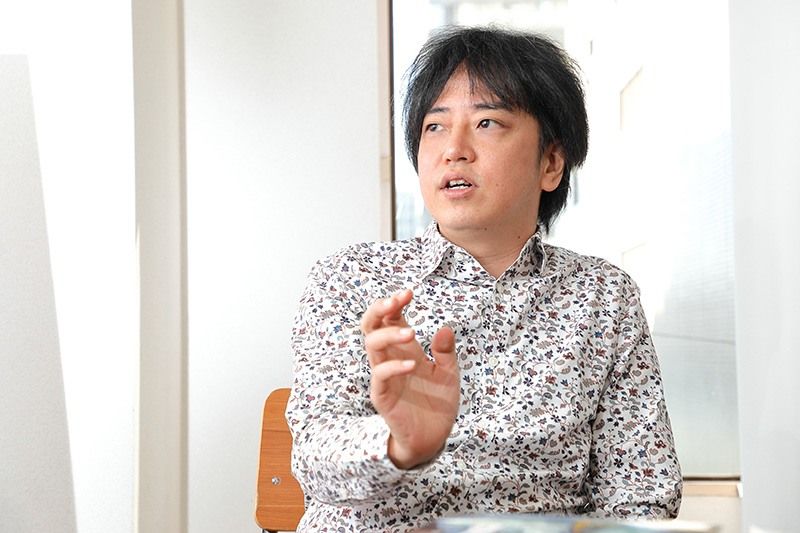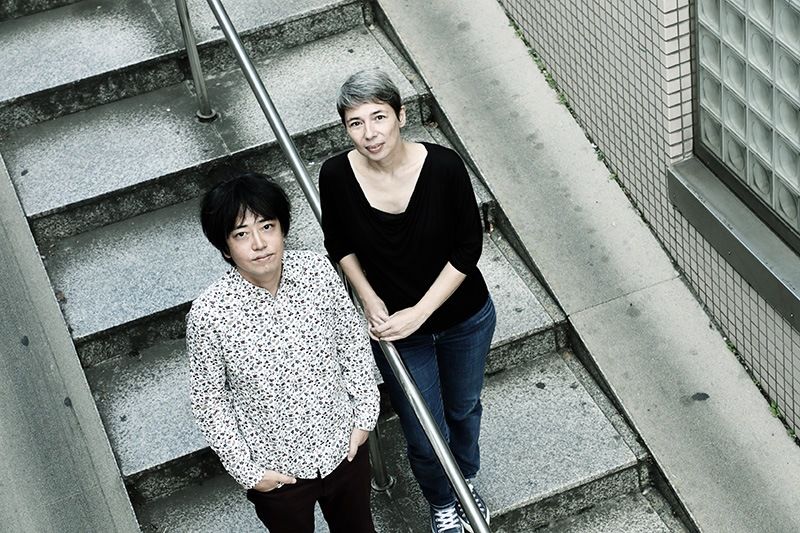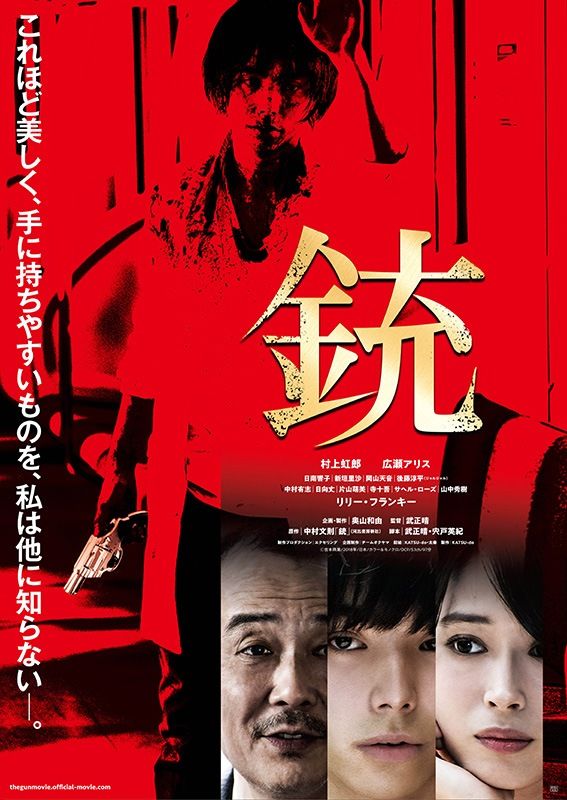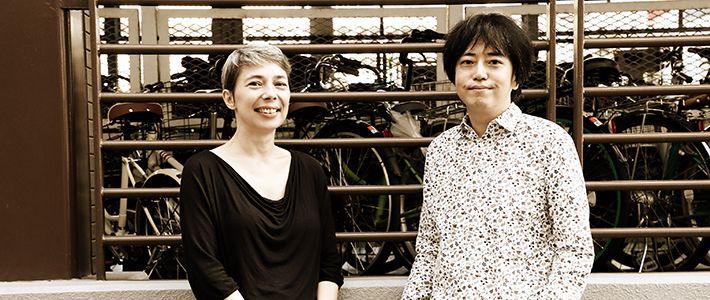
“The Gun”: Literary Tale of Obsession Adapted to Big Screen
Arts Cinema Books Culture- English
- 日本語
- 简体字
- 繁體字
- Français
- Español
- العربية
- Русский
Akutagawa Prize–winning novelist Nakamura Fuminori’s steady output since The Gun, his 2002 debut about a young man whose life spirals out of control after finding a handgun, has earned him a loyal audience both within Japan and overseas. In 2018, The Gun was made into a film, directed by Take Masaharu. By including the internal monologue of the student protagonist, the adaptation is a suitably literary take on Nakamura’s work—but how does Nakamura himself view the film? And how does his French translator see Nakamura’s creative world, which resonates even across differences of language and culture?
The Faceless Protagonist
NAKAMURA FUMINORI What did you think of the film?
MYRIAM DARTOIS-AKO It surprised me. Your writing had taken on a certain form within me, and seeing it in a different form was a little startling.
NAKAMURA Me too. I mean, I wrote the book, and I checked the script, but seeing it on-screen was still surprising. It felt new enough to me that I could forget that I wrote it and let myself be drawn into it. I actually did make one change. It’s the scene towards the end, when Yoshikawa Yūko passes Tōru on campus and says, “You have a problem.” That was the only thing added for the film. Everyone seemed to like the result.
DARTOIS-AKO Was it needed because of the different methods of expression in a film as opposed to a novel?
NAKAMURA The book didn’t need it, but I added it for the film because I was worried that if I didn’t add a hint of tension there things might become monotonous. I left the decision up to the director, but he agreed that the scene should be in there. Murakami Nijirō and Hirose Alice said that shooting it made them nervous because it felt like the core of the film.
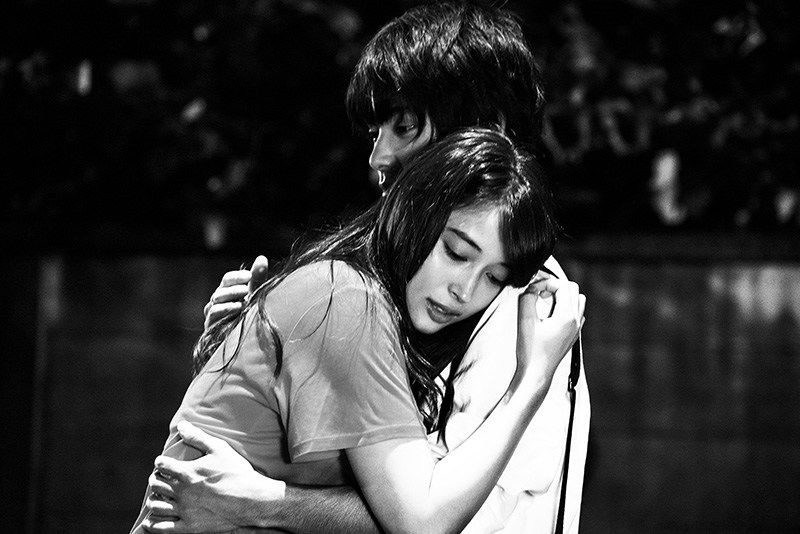 Yoshikawa Yūko (Hirose Alice, left) and protagonist Nishikawa Tōru (Murakami Nijirō) in The Gun. (© Yoshimoto Kōgyō.)
Yoshikawa Yūko (Hirose Alice, left) and protagonist Nishikawa Tōru (Murakami Nijirō) in The Gun. (© Yoshimoto Kōgyō.)
DARTOIS-AKO I’m sure you imagine the characters in your head as you write, but what was it like seeing them in the film?
NAKAMURA I thought they were absolutely perfect. I don’t have any visuals in mind when I write, so it’s always new to see my works on the screen. It wouldn’t be any fun if everything was as I expected, and The Gun surprised me in several ways. The protagonist is the sort of character where what he says on the surface is very different from what he’s thinking inside, so I thought the mismatch between his internal narration and the movements of his lips was an interesting idea. I was also surprised that a black and white film could include such powerful imagery.
DARTOIS-AKO What aspect of the original do you think inspired the decision to film in black and white?
NAKAMURA It could be the style at the sentence level. The whole novel is narrated by a withdrawn protagonist, after all. The black and white idea went from the cinematographer to the director, then the director to the producer, and finally the producer to me, and everyone along the line just said “Brilliant!” That’s always how it is when something new is born. By the way, what about when you’re translating? You do imagine the characters as Japanese while you translate, right?
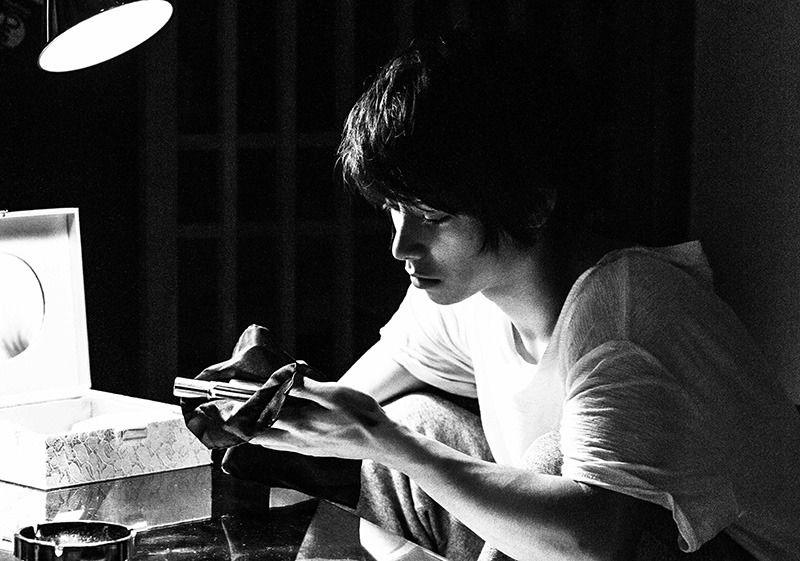 Still from The Gun. (© Yoshimoto Kōgyō)
Still from The Gun. (© Yoshimoto Kōgyō)
DARTOIS-AKO No, actually! For The Gun, I was strictly attentive to the protagonist’s voice, but I had no particular image of his face.
NAKAMURA Me either. I want the reader to imagine it based on the depiction of his inner self.
DARTOIS-AKO When translating work by other writers, there are times when I have to keep the Japanese background in mind, but for most of your books that isn’t the case at all. You can read them without imagining a specific country. And that’s still the case even when Japanese names and places, proper nouns, turn up. The stories themselves could happen to anyone, anywhere, so it’s easy to identify with how the protagonists think and act. I think that, because the themes you deal with touch on the depths of human existence, they overcome any difference in cultural backgrounds or exoticism.
NAKAMURA Dostoyevsky’s stories are about Russia more than a hundred years ago, but they feel familiar. That’s the nature of literature.
Writing that Evokes Visual Imagery
DARTOIS-AKO What I was most conscious of when translating The Gun, partly because I was translating it into French, was Albert Camus’ novel The Stranger.
NAKAMURA The Gun was my debut work, and the influence of The Stranger, especially on the style, was very strong. And it’s a unique kind of “translated” style, coming to Japanese from French. The opening lines, “Today, Mother died. Or maybe yesterday, I’m not sure” (Aujourd’hui, maman est morte. Ou peut-être hier, je ne sais pas.) The opening of The Gun, “Last night, I found a gun. Or you could say I stole it, I’m not really sure” (Kinō, watashi wa kenjū o hirotta. Arui wa nusunda no ka mo shirenai ga, watashi ni wa yoku wakaranai) have almost exactly the same rhythm. It’s very different after that, but how did you render this part in French?
DARTOIS-AKO Exactly the same.
NAKAMURA Really?!
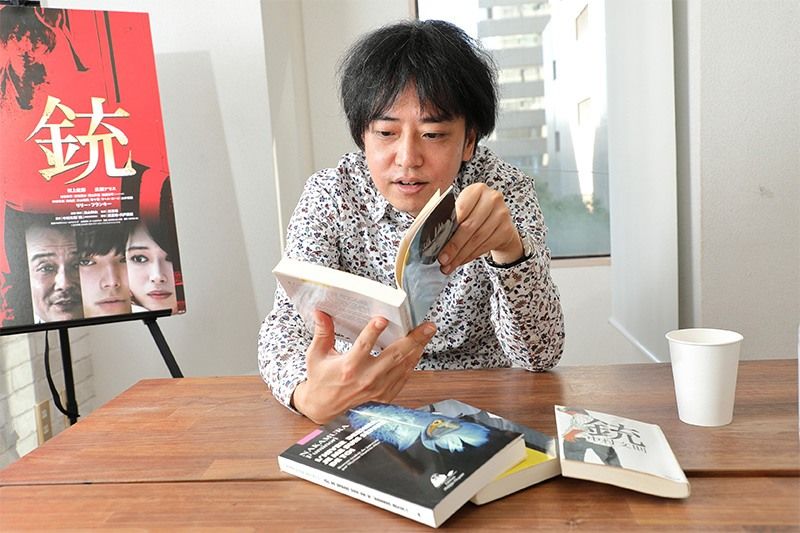 Nakamura Fuminori reads the opening lines of Revolver, Myriam Dartois-Ako’s French translation of his novel The Gun.
Nakamura Fuminori reads the opening lines of Revolver, Myriam Dartois-Ako’s French translation of his novel The Gun.
DARTOIS-AKO The opening of the Japanese translation of The Stranger is faithful to the original, which makes it easy to put back into French. So the opening of the French translation of The Gun is the same as Camus too. This is immediately apparent to a French reader.
NAKAMURA I’m happy to hear that. Translated foreign literature was a strong influence on my debut as a writer. Dostoyevsky was also very influential, but for The Gun, Camus’ style is definitely in there. It’s interesting that the same is true of the French version now.
DARTOIS-AKO It went full circle! Of course, I was careful that the translation was not too dominated by Camus. It’s a very delicate balance. You could call a cinematic adaptation a kind of translation to film, too, couldn’t you? The question that always comes up is whether to read the book or see the film first, but as a translator I’m afraid of letting fixed images dominate my work, so I always start by reading the book.
NAKAMURA That makes sense. At promotional events for the film I always say that it’s fine to start from either one, but as the author of course I do want people to read the book first. [Laughs]
DARTOIS-AKO As I recall, this isn’t the first time one of your books has been filmed, is it?
NAKAMURA It’s the fifth. There have been three this year alone. They make me do PR every time. [Laughs]
DARTOIS-AKO Why do you think so many films are made of your work?
NAKAMURA I just think there are a lot of daring adults in the film industry who like making films like that. [Laughs] I’m happy that Japan’s film industry has so many people who base their adaptations on a proper understanding of the world of the original.
DARTOIS-AKO There might be something about your work that makes it easy to film. Although you did say earlier that you don’t write with images in mind.
NAKAMURA People often tell me that images come to them as they read. If a character has a thought, it can add depth to also describe where they had it. Normally, background description in a novel slows things down, so in my case I try to be brief. Perhaps that makes people feel less like they’re reading and more like images are popping into their mind.
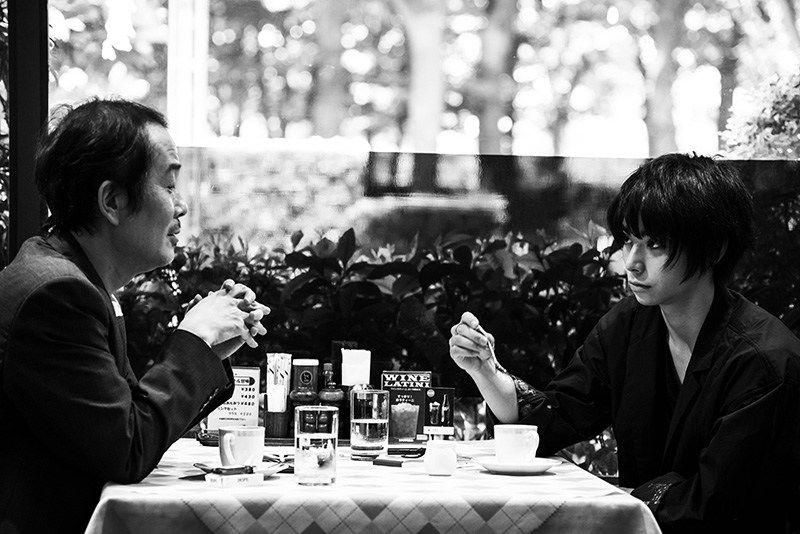 Lily Franky as a detective in The Gun. (© Yoshimoto Kōgyō)
Lily Franky as a detective in The Gun. (© Yoshimoto Kōgyō)
DARTOIS-AKO I love the sharpness of your style. It’s a pleasure to translate. What I’m most careful about is keeping the translation pared down.
NAKAMURA I have a policy of not adding unnecessary sentences. I want to express as many things as I can in sentences that are as short as possible. I think of reading a book as exercise. You want to draw people in and keep them reading, and sluggish sentences get in the way. To write something on paper is very precious. You don’t want any waste in the sentences you put on that paper.
Literature that Crosses Borders
DARTOIS-AKO Do you ever read the English translations of your work?
NAKAMURA I try! Or listen to the audiobooks. But I’m not in a position to judge their accuracy. I just have to leave it to the translators. Sometimes I do wonder about how certain key words are translated and flip through looking for those parts, though.
DARTOIS-AKO It’s very rare that this happens, but when I translated Last Winter We Parted, I got permission from the publisher to exchange manuscripts with the English translator, Allison Markin Powell, before either of our books were published. Because she can read French. And we were both so surprised by each other’s work. It depends on the translator and the publisher, but in France fidelity to the original comes first, while in the English-speaking world they are attentive to the reader, and—from my point of view—have a tendency to do rather bold “editing.” It’s not that one is good and the other bad, just that each country has its own culture of translation.
NAKAMURA I think it’s fine to take the approach that’s suited to that country’s situation. For Turkish and Armenian, there aren’t any translators who work from Japanese, so those editions are retranslations of the English version. There’s no way to check that. So far, The Gun has been published in English, French, and Chinese (traditional characters); the German translation is in progress, and apparently there’s interest from Russia too. I sometimes think that some books are appealing to translators themselves in some way.
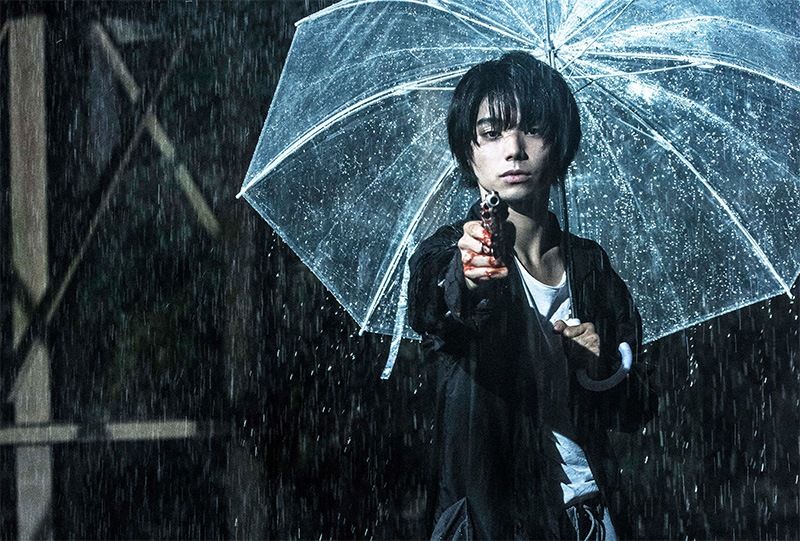 Still from The Gun. (© Yoshimoto Kōgyō)
Still from The Gun. (© Yoshimoto Kōgyō)
DARTOIS-AKO I think any translator who read The Gun would want to give it a try. First and foremost it’s that style. I translated The Thief first, which won the Ōe Kenzaburō Prize, and the offer to do The Gun came after, but the story was unusual, the protagonist had a real inner voice, and the style is sharp. It was all there—it made me eager to take on the challenge.
NAKAMURA The Gun has been out in Japan for 17 years, but it’s still in print. It’s still finding new readers, which I’m grateful for. I wrote it in a very gloomy mood; I was 23, with no steady job and no money. I had a phase where I wrote with the idea of making my debut in mind, but by that point I realized that I needed to go back to the drawing board and just write what I wanted to. And then, years later, it comes out in English and French, and now there’s a movie—it’s a strange feeling.
(Originally published in Japanese on November 16, 2018. Photos by Hanai Tomoko. Text by Matsumoto Takuya of Nippon.com.)
The Gun (2018)
- Cast: Murakami Nijirō, Hirose Alice, Hinami Kyōko, Lily Franky
- Director: Take Masaharu
- Original Story: Nakamura Fuminori
- Screenplay: Take Masaharu, Shishido Hidenori
- Distributor (Japan): Katsu-do, Uzumasa
- Running time: 97 minutes
- Winner of the Japanese Cinema Splash Best Director Award at the thirty-first Tokyo International Film Festival
- Japan release: November 17, 2018
